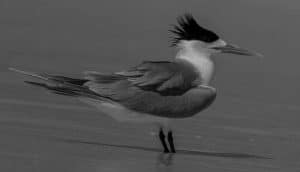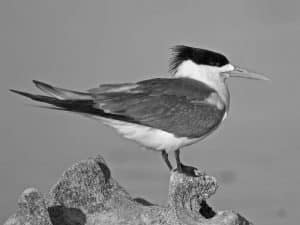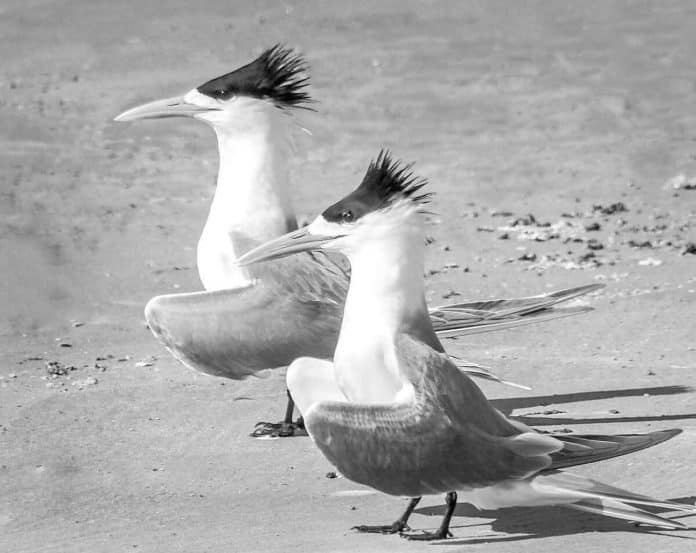Introduction to the Great Crested Tern
The Great Crested Tern, scientifically known as Thalasseus bergii, is a magnificent seabird that can be found along the eastern coast of Tanzania. With its striking appearance and graceful flight, this species has become a favorite among birdwatchers and nature enthusiasts. In this article, we will explore the habitat, physical characteristics, and behavior of the Great Crested Tern, as well as its importance in Tanzania’s coastal ecosystem. Whether you are a seasoned birdwatcher or simply curious about the natural wonders of the country, the Great Crested Tern in Tanzania is a sight not to be missed.
Habitat and distribution of the Great Crested Tern

The Great Crested Tern is primarily a coastal species, inhabiting the sandy beaches, rocky outcrops, and shallow waters along Tanzania’s eastern coastline. This bird can be spotted from the bustling city of Dar es Salaam to the tranquil shores of Zanzibar. It is also found in neighboring countries such as Kenya and Mozambique. The Great Crested Tern is highly adaptable and can be seen in a variety of coastal habitats, including estuaries, lagoons, and mangrove forests. During the breeding season, these birds form large colonies on offshore islands, where they lay their eggs and raise their young.
Physical characteristics and behavior of the Great Crested Tern
The Great Crested Tern is a medium-sized bird, measuring about 45 to 50 centimeters in length and weighing around 400 to 500 grams. It has a sleek body, long wings, and a deeply forked tail, which aids in its agile flight over the ocean. One of the most distinctive features of this species is its crested black cap, which extends from the forehead to the nape. The rest of the body is mainly white, with a black bill and legs. During the breeding season, the plumage of the Great Crested Tern becomes more vibrant, with a reddish-brown tinge on the back and wings.
Importance of the Great Crested Tern in Tanzania’s coastal ecosystem
The Great Crested Tern plays a vital role in Tanzania’s coastal ecosystem. As a top predator in the marine food chain, it helps to regulate the population of smaller fish and invertebrates, contributing to the overall health and balance of the ecosystem. These birds are also excellent indicators of the ecological condition of the coastal areas. By monitoring the population and behavior of the Great Crested Tern, researchers can gain valuable insights into the state of the marine environment and the impact of human activities. Furthermore, the presence of these majestic birds adds to the aesthetic value of Tanzania’s coastal landscapes, attracting tourists from around the world.
Conservation status and threats to the Great Crested Tern

Despite its significance, the Great Crested Tern faces several threats to its survival. Habitat loss and degradation due to coastal development and pollution are major concerns. Human disturbance, including disturbance from tourism activities, can disrupt breeding colonies and cause abandonment of nests. Climate change and rising sea levels also pose a threat by altering the availability of suitable nesting sites and food sources. To protect the Great Crested Tern and ensure its long-term survival, conservation efforts are crucial. This includes the establishment of protected areas, raising awareness among local communities, and implementing sustainable tourism practices.
Best places in Tanzania to spot the Great Crested Tern
If you are keen to catch a glimpse of the Great Crested Tern in Tanzania, there are several prime locations to visit. Saadani National Park, located on the coast of the Indian Ocean, offers a unique opportunity to observe these birds in their natural habitat. The nearby islands of Zanzibar and Pemba are also known for their thriving populations of Great Crested Terns. For those willing to venture further, the remote Mafia Island Marine Park provides an untouched paradise where you can witness these elegant seabirds in their full glory. Remember to bring your binoculars and a camera to capture the breathtaking moments.
Tips for observing and photographing the Great Crested Tern
To make the most of your experience observing and photographing the Great Crested Tern, here are a few tips to keep in mind. Firstly, be patient and allow the birds to become accustomed to your presence. Avoid making sudden movements or loud noises that may startle them. Secondly, choose a suitable vantage point that offers a clear view of the birds’ flight paths and feeding areas. This will increase your chances of capturing stunning images. Lastly, respect the wildlife and their habitats by following ethical guidelines for wildlife photography. Remember that the welfare of the birds should always come first.
Other bird species found in the same habitat as the Great Crested Tern
The coastal habitats of Tanzania’s eastern waters are home to a rich diversity of bird species, in addition to the Great Crested Tern. Some of the notable species you may encounter include the Sooty Gull, Lesser Crested Tern, and White-fronted Plover. These birds share similar habitats and ecological niches, creating a vibrant and interconnected bird community. Exploring the coastal areas of Tanzania offers an opportunity not only to witness the beauty of the Great Crested Tern but also to appreciate the intricate web of life that exists within this unique ecosystem.
The role of ecotourism in protecting the Great Crested Tern

Ecotourism plays a crucial role in protecting the Great Crested Tern and its habitat. Responsible tourism practices can generate income for local communities, incentivizing them to conserve the natural environment and wildlife. By promoting sustainable tourism initiatives, such as guided birdwatching tours and educational programs, we can raise awareness about the importance of protecting the Great Crested Tern and its coastal ecosystem. Additionally, ecotourism can contribute to scientific research and monitoring efforts, providing valuable data for conservation planning and management.
Conclusion: Appreciating the beauty and significance of the Great Crested Tern in Tanzania’s Eastern Waters
In conclusion, the Great Crested Tern is a true coastal delight along Tanzania’s eastern waters. Its striking appearance, graceful flight, and important ecological role make it a species worth admiring and protecting. By understanding its habitat, physical characteristics, and behavior, we can better appreciate the beauty and significance of this magnificent seabird. Whether you are a birdwatcher, nature enthusiast, or someone simply curious about the wonders of the natural world, a visit to Tanzania’s coastal areas offers a chance to witness the Great Crested Tern in its natural habitat. Let us cherish and preserve this coastal delight for generations to come.

































